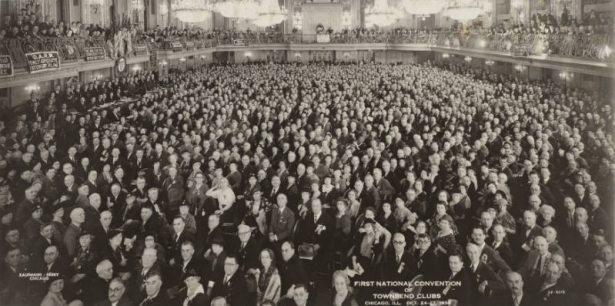The panoramic photo is a format that's been given a new life by smartphone cameras, but it's actually a photographic technique that dates back to the 1850s. And during its roughly 160-year life, the panoramic photo has done an amazing job of capturing images of large groups of people and expansive views of scenic vistas.
A panoramic photo differs from a traditional photo in that it captures a wider field of view. This effect can be created either with a camera that's equipped for wide angle shots, or by stringing together several smaller, individual images into one larger image in a darkroom.
For example, the image at the top of this page is the middle piece of a three-piece panoramic image of Denver, taken by L.C. McClure in the late 19th or early 20th Century. The complete picture is shown below.
Not surprisingly, the panoramic photo is one of the mainstays of our photo collection at the Western History and Genealogy Department at the Denver Public Library. Our department houses multiple collections of panoramic photos that cover topics such as Leisure and Amusement and Businesses and Organizations. These collections are quite large and don't even include all of the panoramic photos in our collection.
So why is it that panoramic photography occupies such a large space in our collection? From a landscape perspective, panoramic shots give us an incredibly detailed view of what Western spaces looked like at any given time. This allows us to fully take in the impact of human activity on the western landscape or the massive changes that have taken place in urban areas.
Panoramic photos are also uniquely suited for photographing large groups of people. In fact, one of the earliest uses of this technique was to capture military units and it's a practice that is still in use today. Our collection contains dozens of panoramic shots of soldiers and many more of civilian groups such as theater companies and civic organizations.
These photos can be a real boon to genealogists as, oftentimes, the names of the people in the photo are written or typed on the back of the print.
Panoramic photos also tend to illuminate an unfortunate aspect of life in the United States, and that is rampant segregation, as the following 1935 photo of the Townsend Plan convention indicates in a fairly stark manner.
Sharp-eyed readers will notice that this room is completely devoid of anyone who isn't white. Unfortunately, this picture is not an anomaly. People of color are rarely represented in these photos and that seems to be an accurate reflection of the barriers to civic life that marked their experience in Denver, and elsewhere in the United States. This is, of course, a failing of society and not of a particular photographic style or a particular photographer.
In fact, omissions such as this frequently speak volumes about a particular group or era and add much to our understanding of how our society functioned in times past. And, as the image above shows, panoramic photos of people of color were not non-existent. Panoramic photos of mixed groups, however, are extremely few and far between in our collection.
If you'd like to see more panoramic photos, check out our Panoramic photo gallery.




![Panoramic view of the cast of Arthur Hockwold's "Struttin' Sam from Alabam'" musical company, presented at the Broadway Theater, 1756 Broadway, in Denver, Colorado. African American men and women and one white man sit and stand in front of the theater near the canopied front entrance. Sign on the canopy reads: "50 People [with] Orchestra." Sign on the window reads: "Broadway Rotisserie."](/sites/history/files/styles/blog_image/public/cdm_62853_0.jpg?itok=9Tphp-wQ)
Comments
Is the photo gallery you
Is the photo gallery you mention something that's online, is it a physical gallery in the library, how do I access it? I couldn't seem to figure it out from this article.
Add new comment